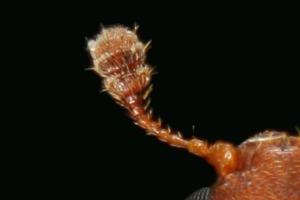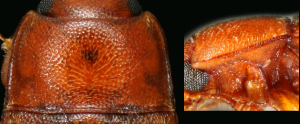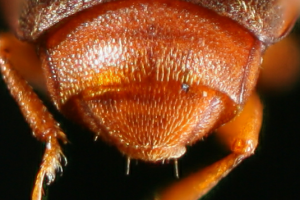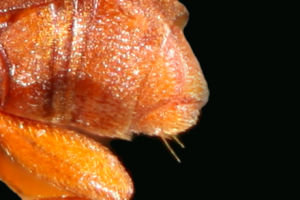Species Fact Sheet
Carpophilus marginatus Erichson, 1843
Diagnosis: Carpophilus marginatus specimens are distinguished from other eastern North American species by having the following combination of features: length measured from mandibles to abdominal apex 1.8-2.6 mm, antennomere coloration unicolorous throughout antennae (Fig. 2), pronotum posterior angle nearly forming a 90 degree angle (Fig. 3), and the posterior rim of the mesocoxal cavities smooth forming an axillary space extending approimatly 1/4 to 1/2 down the metepisternal suture. Males also have two distinctly longer setae on their supplementary segment (Fig. 4 & 5).
Distribution: Carpophilus marginatus is found in eastern North America from New York to Florida and west from Michigan to Alabama. It has also been recorded in Oregon, Louisiana, Costa Rica, and Guatemala.
Biology: Very little is known about the biology of C. marginatus. It has been collected from oak sap flows, freshly-cut oak, and southern red oak (Vogt 1950; Williams et al. 1997; Gil, 2008). Also collected from figs (Riley and Howard 1889).
Reference:
Gil S (2008) – collection data
Powell GS (2017) – collection data (Costa Rica)
Riley CV, Howard LO (1889) – collection data
Williams RN, Ellis SM, Teraguchi S (1997) – collection data
Vogt GB (1950) – data collection
Double-click on images to enlarge
HOW TO CITE THIS WORK:
DiLorenzo, C.L., G.S. Powell, A.R. Cline, and J.V. McHugh (2021) Carpophiline-ID, a taxonomic web resource for the identification of Carpophilinae (Nitidulidae) of eastern North America. (vers. 01.19.2021) University of Georgia, retrieved from https://site.caes.uga.edu/carpophiline-id/




